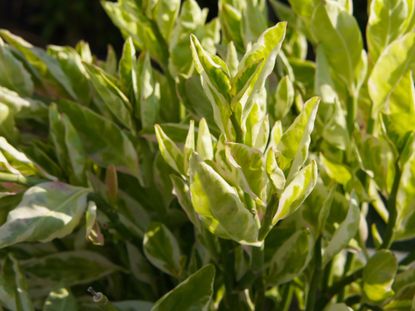Devil's Backbone Plant Info: How To Grow The Devil's Backbone Plant Indoors


There are numerous fun and descriptive names for the devil's backbone houseplant. In an effort to describe the blooms, devil's backbone has been called red bird flower, Persian lady slipper, and Japanese poinsettia. Descriptive monikers for the foliage include rick rack plant and Jacob's ladder. Whatever you call it, learn how to grow the devil's backbone plant for unique and easy to care for indoor flora.
Devil's Backbone Plant Info
The scientific name for this plant, Pedilanthus tithymaloides, means foot-shaped flower. The plant is native to the American tropics but only hardy in USDA zones 9 and 10. It makes a superb houseplant with its 2 foot (61 cm.) tall stems, alternate leaves, and colorful “flowers” which are actually bracts or modified leaves.
The leaves are lance-shaped and thick on wiry stems. The bract color may be white, green, red, or pink. The plant is a member of the spurge family. No devil's backbone plant info would be complete without noting that the milky sap may be poisonous to some people. Care should be exercised when handling the plant.
How to Grow the Devil's Backbone Plant
Growing the plant is easy and propagation even simpler. Just cut a 4 to 6 inch (10-15 cm.) section of the stem from the plant. Let the cut end callus for a few days and then insert it into a pot filled with perlite. Keep the perlite lightly moist until the stems root. Then repot the new plants in a good houseplant potting soil. Care of devil's backbone babies is the same as the adult plants.
Growing Pedilanthus Indoors
Devil's backbone houseplant likes bright indirect sunlight. Plant in direct sun in fall and winter but give it a little protection from stinging hot rays in spring and summer. Just turning the slats on your blinds can be enough to keep the tips of the leaves from sizzling. Water the plants when the top few inches (8 cm.) of soil feels dry. Keep it only moderately moist, yet not soggy.
The plant produces the best growth with a once per month fertilizer solution diluted by half. Devil's backbone houseplant does not need to be fed in the dormant seasons of fall and winter. Choose a draft free location in the home when growing Pedilanthus indoors. It doesn't tolerate cold breezes, which can kill off the tips of the growth.
Long Term Care of Devil's Backbone
Repot your plant every three to five years or as needed in a rich houseplant mix with plenty of sand mixed in to increase drainage. Use unglazed pots, which allow excess moisture to freely evaporate and prevent wet root damage. Unchecked plants may get up to 5 feet (1.5 m.) in height. Prune off any problem branches and trim back lightly in late winter to keep the plant in good form.
Gardening tips, videos, info and more delivered right to your inbox!
Sign up for the Gardening Know How newsletter today and receive a free download of our most popular eBook "How to Grow Delicious Tomatoes."

Bonnie Grant is a professional landscaper with a Certification in Urban Gardening. She has been gardening and writing for 15 years. A former professional chef, she has a passion for edible landscaping.
-
 Crops for Urban Growing: 8 Edible Plants For Urban Gardens
Crops for Urban Growing: 8 Edible Plants For Urban GardensUrban edible gardening lets your yard do double duty of beauty and practicality. Have fun combining edible plants with ornamentals.
By Teo Spengler
-
 Clever Vertical Vegetable Garden Ideas For Small Spaces – 7 Ways To Save Space
Clever Vertical Vegetable Garden Ideas For Small Spaces – 7 Ways To Save SpaceShort on garden space? Learn some vegetable garden ideas for small spaces that are fun and easy.
By Mary Ellen Ellis